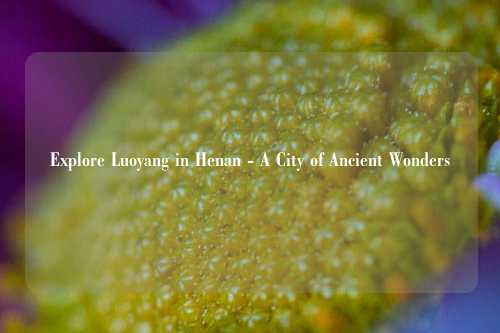Explore Luoyang in Henan - A City of Ancient Wonders
Discover the Ancient Charm of Luoyang
Luoyang, a city nestled in the heart of Henan Province, is one of China's oldest and most historically significant cities. With a rich history that spans over 4,000 years, it has served as the capital for several ancient Chinese dynasties, leaving behind a legacy of cultural and architectural wonders. Known as one of the birthplaces of Chinese civilization, Luoyang is brimming with historical landmarks, ancient temples, and cultural heritage that make it a must-visit destination for history enthusiasts and travelers alike.
Luoyang’s Historical Significance
As one of the Four Great Ancient Capitals of China, Luoyang’s history is deeply intertwined with the development of Chinese culture and civilization. The city has been the capital of nine different dynasties, including the Eastern Zhou, Eastern Han, and the Tang Dynasty. During these periods, Luoyang flourished as a political, economic, and cultural hub, attracting scholars, artists, and traders from across the empire. Its significance is reflected in the vast array of archaeological sites and historical monuments that can be found throughout the city.

One of the most remarkable aspects of Luoyang's history is its role in the development of Confucianism, Buddhism, and Taoism. The city is home to several important temples, monuments, and relics that showcase the deep spiritual and philosophical roots of these traditions. A visit to Luoyang offers an opportunity to step back in time and explore the roots of Chinese thought, culture, and religion.
The Longmen Grottoes: A Marvel of Buddhist Art
One of the most famous and awe-inspiring attractions in Luoyang is the Longmen Grottoes, a UNESCO World Heritage Site located just outside the city. These grottoes, carved into the cliffs of the Yi River, contain over 100,000 Buddhist statues, including some of the finest examples of Buddhist art from the Northern Wei, Tang, and other dynasties. The carvings are a testament to the skill and devotion of the artisans who created them over 1,500 years ago.
The Longmen Grottoes are an important pilgrimage site for Buddhists and art enthusiasts alike. The largest and most impressive statue is that of Vairocana, a colossal image of the Buddha that stands at 17 meters tall. Visitors can wander through the hundreds of caves, each filled with intricately carved statues and religious scenes. The combination of religious significance and artistic beauty makes the Longmen Grottoes one of the most important cultural sites in China.
The Ancient Temples and Historical Relics
In addition to the Longmen Grottoes, Luoyang is home to several other ancient temples that highlight the city’s religious and cultural heritage. The White Horse Temple, founded in the Eastern Han Dynasty, is considered the birthplace of Chinese Buddhism. It is here that Buddhism was first introduced to China from India, and the temple remains a significant site for Buddhist practice and study.
Another important temple in Luoyang is the Zhongyue Temple, located at the foot of Mount Song. This temple, dedicated to the Taoist god of Mount Song, is one of the oldest Taoist temples in China. With its impressive architecture and tranquil surroundings, the Zhongyue Temple offers visitors a chance to explore Taoist philosophy and religion.
The city is also home to numerous historical relics and monuments, such as the Luoyang Museum, which houses an extensive collection of ancient artifacts, including pottery, jade, and bronze items. These relics offer a glimpse into the daily life, art, and culture of ancient Chinese civilizations.
The Ancient City of Luoyang: A Glimpse into the Past
Exploring the ancient streets of Luoyang is like stepping back in time. The city’s historic district is filled with traditional architecture, ancient gates, and well-preserved buildings that provide a glimpse into its rich past. Visitors can explore the remnants of Luoyang's ancient city walls, which were constructed during the Tang Dynasty. These walls once enclosed the city and served as a defense against invaders. Today, they are a symbol of the city's historical resilience and offer panoramic views of the surrounding area.
One of the best ways to experience the ancient city is by walking through the bustling streets of the Old City. Here, visitors can find traditional markets, local artisans, and street vendors selling a wide range of goods, from handmade crafts to local delicacies. The area is a vibrant mix of old and new, where ancient traditions meet modern life.
The Peony Festival: A Celebration of Beauty and Culture
One of the most famous events in Luoyang is the annual Peony Festival, which takes place every spring. The city is known for its beautiful peonies, which have been cultivated in the area for over 1,500 years. During the festival, Luoyang's parks and gardens are filled with blooming peonies in a stunning array of colors. The festival is a celebration of both the beauty of nature and the cultural significance of the peony in Chinese art and literature.
The Peony Festival attracts visitors from all over China and the world, who come to admire the flowers, enjoy cultural performances, and participate in various activities. The festival also features traditional Chinese music, dance, and art, making it a lively and colorful event that showcases the rich cultural heritage of Luoyang.
Exploring Luoyang’s Scenic Beauty
Beyond its historical and cultural attractions, Luoyang is also known for its scenic beauty. The city is surrounded by mountains, rivers, and lush countryside, providing a stunning natural backdrop for visitors to explore. One of the most famous natural attractions in the area is the Songshan Mountain, which is located just outside of the city. Songshan is one of the Five Sacred Mountains of China and is home to several ancient temples and monasteries.
For those who enjoy outdoor activities, there are plenty of opportunities for hiking, boating, and sightseeing in the surrounding countryside. The nearby Yuntai Mountain, famous for its dramatic cliffs, waterfalls, and ancient temples, is another popular destination for nature lovers and adventurers. The natural beauty of Luoyang and its surroundings provides the perfect complement to the city’s historical and cultural treasures.
The Luoyang Cuisine: A Taste of Tradition
No visit to Luoyang would be complete without sampling the local cuisine. The city is known for its unique style of cooking, which combines the flavors of northern and southern Chinese cuisine. Some of the most popular dishes in Luoyang include Luoyang Water Banquet, a multi-course feast that showcases the city’s rich culinary heritage. The banquet consists of a variety of dishes made with fresh, local ingredients, including soups, dumplings, meats, and vegetables, all prepared in traditional methods.
Another famous dish is the Luoyang Sliced Noodles, a type of handmade noodle that is often served with a flavorful broth and various toppings. The city’s street food scene is also vibrant, with vendors offering a wide range of snacks and treats, including steamed buns, dumplings, and savory pancakes. The combination of traditional flavors and unique ingredients makes Luoyang’s cuisine a true delight for food lovers.
Why Visit Luoyang?
Luoyang offers a truly immersive experience for travelers who are interested in exploring China’s rich cultural and historical heritage. From its ancient temples and Buddhist grottoes to its scenic landscapes and vibrant festivals, the city offers something for everyone. Whether you are a history buff, an art lover, a nature enthusiast, or a foodie, Luoyang provides a wealth of experiences that will leave a lasting impression.
The city’s historical significance, combined with its natural beauty and rich cultural traditions, makes Luoyang an essential destination for anyone seeking to understand the depth of Chinese history and culture. A visit to Luoyang is not just a trip to a city—it is a journey through time, a chance to explore one of China’s most ancient and enduring cities.
















